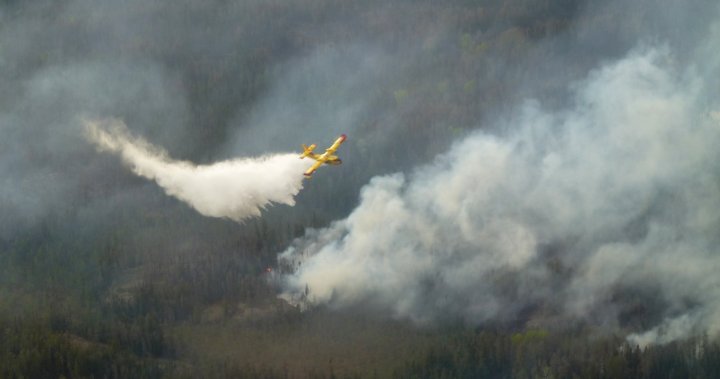With more than 200 active wildfires across Canada, the smoke from the blazes is spreading, even drifting south to cloud over multiple U.S. states.
Air quality alerts stretch from Alberta to parts of northern Ontario, according to Environment and Climate Change Canada, while Minnesota and Michigan are seeing air quality levels that can be classified as “hazardous” and others deemed “very unhealthy.”
According to weather alerts by Environment Canada, various Ontario communities are expected to see poor air quality and reduced visibility with wildfire smoke remaining in place for potentially several days in some areas.
Several warnings are in effect for northwest Alberta and central Saskatchewan and Manitoba, while air quality statements are in place for northeast B.C., east central Alberta and Saskatchewan, and small parts of Manitoba.
Northern U.S. states dealing with smoke
The upper U.S. Midwest has been seeing the majority of impacts from wildfire smoke, with Minnesota on Monday advising air quality would enter the unhealthy category in the east central, southeast and northeast parts of the state, with its alert in place until Wednesday.
Get daily National news
Get the day’s top news, political, economic, and current affairs headlines, delivered to your inbox once a day.
“A band of very heavy smoke from Canadian wildfires continues to move southeast across Minnesota and has reached south central and northeast Minnesota Tuesday morning,” a news release from the Minnesota Pollution Control Agency stated.
The agency warned east central, southeast and northeast Minnesota would see fine particle levels reach the red “unhealthy” air quality index category, with the Twin Cities among the communities being urged to avoid prolonged or heavy exertion and limit time spent outdoors.
Western, central and north-central parts would see the orange level, which is considered unhealthy for sensitive groups.
However, IQAir, which tracks the air quality index, shows communities like Ely, Minn. and Houghton, Mich. are already seeing levels in the “hazardous” threshold.
The Wisconsin Department of Natural Resources has also recommended people limit time outdoors until at least Tuesday, noting multiple air quality advisories have been put in place due to Canadian wildfire smoke.
The agency said smoke would be moving northwest to southeast throughout Tuesday, with its advisory expected to extend to the full state later in the day.
Nebraska’s Department of Health and Human Services issued a smoke advisory for the eastern part of the state, warning smoke associated with wildfires in Canada may affect air quality with parts of the state potentially seeing unhealthy air later in the day.
According to BlueSky’s forecast, the smoke from Canada’s wildfires is expected to continue to drift southeast and could reach Iowa and Nebraska.
© 2025 Global News, a division of Corus Entertainment Inc.


